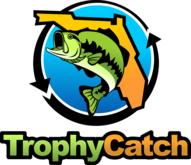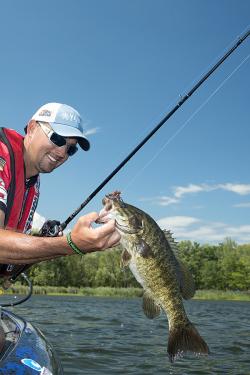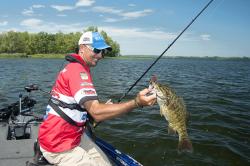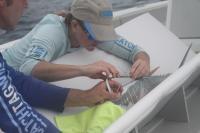Forest buffer research reveals more benefits than previously thought
Here’s food for thought for land managers all over the nation from Karl Blankenship, Editor of The Bay Journal, the great conservation publication that keeps watch over Chesapeake Bay.
from The Fishing Wire
White Clay Creek at Stroud Center has transformed from ‘impaired’ stream into habitat for trout.
By Karl Blankenship, Editor
The Bay Journal; www.bayjournal.com.

Stroud Water Research Center
The Stroud Water Research Center in Chester County, PA. (Dave Harp)
Standing amid tall trees next to White Clay Creek, listening to the forest birds sing and the water splash along rocks, roots and fallen branches, one could imagine the creek had always looked like this.
But, walking through the site one summer afternoon, Bern Sweeney pointed to a tell-tale sign that the site wasn’t as pristine as it appeared. “If you look over there,” he said, “the trees are all in rows.”
Just a bit more than three decades ago a cornfield grew right to the edge of the stream. Another section was a pasture, again to the edge of the stream.
Sweeney and other scientists from the Stroud Water Research Center planted trees on a portion of the field and the pasture, and have been watching – and studying – changes ever since.
Just a few hundred yards downstream, the creek winds through a meadow and is so narrow a person could jump across. Here, among the tall trees, it requires a bridge – even though this upstream site was carrying less water.
“There is a lot of stuff happening here that is not happening down there,” said Sweeney, who helped plant the rows of trees as a young scientist and is now the center’s director. Despite the unnatural neat rows of trees, they have helped to transform what was once an “impaired” stream into one of the healthiest waterways in the region, with reduced pollution and improved habitat – and one that seems to keep getting better over time.
Located in Chester County, PA, the 48-year-old Stroud Center is just outside the Chesapeake Bay watershed, but its work, dating to that first planting in 1982, has greatly influenced Bay restoration efforts.
Its research was pivotal in convincing the state-federal Bay Program partnership that forested stream buffers should be a key restoration objective. That led the Bay Program in 1996 to adopt the nation’s first regional forest buffer restoration goal. That, in turn, led to the creation of the U.S. Department of Agriculture’s Conservation Reserve Enhancement Program, which made funding available to plant buffers and resulted in the quick achievement of the initial, 2,010-mile buffer goal.
“I do not believe the Bay region would be a champion of riparian forest buffers had it not been for the early intervention and education provided by Stroud,” said Ann Swanson, executive director of the Chesapeake Bay Commission, an advisory panel representing state legislatures that was a champion of the forest buffer goal.
Sweeney and Stroud scientists showed policy-makers like Swanson how forest buffers were the last line of defense for waterways against the human activities on the watershed. They could slow runoff, absorb nutrients and trap sediment before the pollutants could reach streams.
“Their science has been crucial to our understanding of how streams work and what makes them healthy,” said Al Todd, who is now executive director of the Alliance for the Chesapeake Bay but in the mid-1990s led U.S. Forest Service efforts to develop a Bay buffer policy.
“But more than just doing good science, people like Bern Sweeney have the unique ability to tell the story of riparian forests and stream health in a way that anyone can understand,” Todd said. “And Sweeney has not been timid about telling farmers or policy-makers they need to pay attention.”
More reductions than thought
One of the things that Sweeney and colleagues increasingly stress is that forest stream buffers are substantially different from other management practices used to control runoff. Not only are they highly effective at reducing nutrient runoff, but buffers also provide a host of additional stream benefits, such as stabilizing banks, regulating water temperatures and improving habitat quality.

White Clay Creek
White Clay Creek, once an “impaired” stream, is now one of the healthiest waterways in the region, and it seems to keep getting better over time. (Dave Harp)
New research by scientists at the center offers tantalizing hints that buffered streams may reduce nutrients even more than previously thought.
Furthermore, many benefits related to a forest buffter appear to increase as the buffer ages – unlike other pollution control efforts, such as grass buffers, which become less effective over time.
The center has stepped up efforts to spread the word about buffers – and helped to get more of them on the ground. It has increased research about cost-effective ways to plant buffers, and it established a new watershed restoration group to quickly translate its science into on-the-ground initiatives. “We see it as a way to directly inject science into an applied role,” Sweeney said. “And that needs to happen.”
Indeed. The rate of forest buffer plantings in the Bay watershed has dropped sharply in the last decade. Last year, just a little more than 200 miles were planted, down from a peak of more than 1,100 miles in 2002, and well short of the 900-mile-a-year goal contained in the new Chesapeake Bay Watershed Agreement.
Numerous factors have contributed to the trend: High commodity prices have made farmers reluctant to take crop land out of production to plant buffers, and the bureaucracy involved with the CREP program – which funds most buffer plantings – can be difficult for landowners to navigate.
Also, state restoration programs often haven’t prioritized forest buffers. Virginia instead has prioritized stream bank fencing to keep cows out of streams, and along a narrower band than is required for an effective buffer. Maryland’s forest buffer goals are modest compared with those of other states.
In Pennsylvania, the state legislature recently sided with builders and their allies to roll back a requirement that new development in state-designated exceptional value or high-quality watersheds maintain a 150-foot buffer along streams, contending water quality objectives could be met with other pollution control technologies.
Environmental groups and the state Fish and Boat Commission – citing Stroud’s work – argued that other pollution control practices could not match the full range of stream services provided by forest buffers. They lost.
Such emphasis on pollution reduction, rather than a more holistic view of stream health, frustrates buffer advocates. “I think the segregation of the Bay goals from local water quality sometimes has not helped,” said Matt Ehrhart, director of watershed restoration at the Stroud Center, and former executive director of the Chesapeake Bay Foundation’s Pennsylvania office. In Pennsylvania, he noted, streams are placed on the impaired waters list based on the presence of insects and benthic organisms that generally need conditions provided by forests.
Forest buffers are not a silver bullet that eliminates the need for other pollution-control practices upland, Ehrhart cautioned. But they provide an essential part of the solution, especially when it comes to stream health.
“At the end of the day, you can reduce phosphorus, but if you don’t have cooler temperatures and the conditions that foster your stream ecology, you won’t see the local changes that we’re looking for,” Ehrhart said. “Or trout.”
Forests vs. grass buffers
When Capt. John Smith explored the “faire bay” fed by “clear rivers and brooks,” he noted the landscape was “overgrown with trees.” Smith may not have recognized that the condition of the Bay and its tributary rivers was closely linked to the trees. At the time of his explorations in 1607-08, an estimated 95 percent of the watershed was forested.
The giant trees, their expansive root system, along with understory plants, greedily absorbed available nutrients. Their roots held sediment in place, resulting in a network of clean waterways that fed the Bay. Sweeney characterized the wholesale clearing of forests following European colonization as perhaps having the most devastating impact on Eastern streams.
As forests were removed, sediment and pollution entering waterways increased. Water quality worsened, and sunlight pounded the water, making it too warm for trout. Fish and other aquatic dwellers began to disappear. Flooding increased. Soil from clear-cut uplands flooded into valleys where it was trapped by a proliferation of small dams that powered grist and saw mills, smothering floodplains.
When grasses replaced trees along streams, as in the meadow immediately downstream of Stroud’s forested research site, they proactivey extend their root systems into the water and trap sediment. The sod that is formed at the stream edge causes the stream banks to gradually creep towards one another – narrowing the stream to an unnatural configuration. That forces the stream to dig deeper, cutting a narrow, steep-sided channel through the soil. Eventually, the channel digs below the roots, and begins eating away at the banks, causing the surface to collapse into the stream, releasing sediment but, more importantly, causing instability as the stream rapidly moves in an unnatural way across its floodplain.
No trees along a stream also means no leaves to fuel the diverse variety of insects and microorganisms that evolved in the stream over thousands of years of forest cover. Steady influxes of sediment from destabilized stream banks would smother much of their bottom habitat, anyway.

Bern Sweeney
Bern Sweeney conducts a Stream and Buffer Ecology Workshop along White Clay Creek at the Stroud Water Research Center. (Dave Harp)
But along reforested sections of White Clay Creek, some of those lost functions are returning. The stream channel has widened and stabilized. Diverse stream insects thrive. Instead of a mud-covered bottom, the creek has pools, riffles and runs, offering habitat variety. Each fall, the food chain is fed by a huge influx of leaves – almost all of which are consumed before they can travel 100 yards downstream.
Sweeney is cautious about using words like “pristine” or “natural” to describe the stream. That’s because there are no untouched streams in the Piedmont for comparison. “We don’t have the ultimate reference site.” And, outside the stream channel, a layer of built-up sediment remains beyond the edges of the stream, over what was once a larger floodplain.
But, it does have something it didn’t used to: a reproducing trout population.
“I would argue it is a functional stream, ecologically,” Sweeney said, noting the state now classifies it as an “exceptional value” waterway. “It is a protected stream because it is so close to being natural. It has a great community in it with reproducing trout. We know that it processes nitrogen effectively. It works.”
Lessons learned
Almost everything along the stream seems to be monitored. The creek is lined with monitoring wells on either side so scientists can test water quality at different depths as it moves through the forest along the stream. Nets over the stream even collect flying aquatic insects.
The monitoring gives scientists new information about how the stream works. As it has gotten wider and shallower, the water it carries is more likely to come into contact with the microbes and insects that dwell on the bottom. Those organisms consume, or otherwise alter material, that the stream is carrying. Bacterial communities can remove pollution-causing nitrogen compounds from the water by turning it into harmless nitrogen gas – a process known as denitrification. Others break down pollutants such as pesticides into harmless components.
Some of those functions can take place in narrower streams, but the increased amount of stream bottom, combined with the presence of rocks, riffles and roots that slow the water through wooded areas, gives those organisms a greater opportunity to “process” the streamwater.
That’s further enhanced in the fall when an influx of leaves pours into the stream, providing more surface areas for bacteria, and food to fuel their growth – the leaves themselves. “All of a sudden we see a huge increase in the stream’s ability to take up something like nitrogen,” Sweeney said. “A deforested stream is not going to have that.”
Those processes may get better with age, according to Sweeney, as the wide forest streams stabilize and the trees exert more influence over the local environment, including the microbial communities in both the soil and the water. In addition, as trees become old and begin to drop “large woody debris” into waterways, those tree limbs and trunks provide additional habitat for still more organisms, and further slow the water, allowing more processing time.
Researchers at Stroud are hard at work trying to quantify those added benefits associated with forest buffers. “We don’t have a good handle on that yet, and those are really important services that we need to quantify because it puts additional value on the buffer,” Sweeney said.
But some research by Stroud scientists about the added denitrification potential of forested streams has begun to influence policy. An expert panel reviewing the Bay Program’s assumptions about forest buffer nutrient reductions recently gave a nod to that work. Historically, the Bay Program’s estimates of forest buffer nutrient removal were based solely on what happened in the buffers. In an updated recommendation, the panel suggested that streams with forest buffers on both sides be given an additional 4 percent nitrogen reduction credit because of the in-stream processes.
Sweeney thinks research will eventually show the in-stream benefits are even greater. “In my opinion, I think at some point the in-stream aspects that are associated with a forest buffer are going to actually be greater than what we are getting from the filtration from the buffer, or at least equal to,” he said.
“We weren’t even paying attention to this back in 1990 when we started talking about buffers, and now we realize that this is a big part of the overall equation.”
Sweeney wants to see the lessons learned at Stroud transferred to technicians who work with landowners, and to policy-makers and the staffs of agencies and environmental groups. That was the impetus for the launch last year of the center’s Watershed Restoration Group which, besides Ehrhart, also employs former Pennsylvania CBF staffers David Wise and Lamonte Garber.
The disconnect between what scientists know about the function of buffers and the policies and technology that guides their implementation has had real-world consequences. Sweeney had learned from the earliest planting along White Clay Creek, that if newly planted seedlings were not protected from invasive plants and browsing deer, they were unlikely to survive. He and colleagues published a paper in 2002 showing the importance of using 5-foot tree shelters and herbicide treatments for the survival of tree plantings.
But that paper went unseen by people working in the field, and funding for those actions was not initially included in federally funded buffer planting programs. “That gap in knowledge killed a lot of trees for three years,” Ehrhart said.
Staff from the restoration group, along with scientists, conduct workshops and meet with professionals throughout the region to tout the latest information and techniques.
Meanwhile, the center is branching out into new research to better address buffer planting issues. For instance, the use of herbicides is generally considered essential to keep invasive plants from overwhelming newly planted trees. But that’s not an option for organic farmers interested in tree buffers, so they are looking into non-herbicide methods, such as placing stone around seedlings to keep plants away.
Voles, tiny mouselike animals, can be a plague on newly planted trees. The biodegradable plant shelters that are routinely placed around seedlings to protect them from deer sometimes become “vole condos” in which the trees fall victim to small mammals instead of large ones. Stroud is experimenting with a product from Europe that has a small tree tube to exclude voles within the larger tube that excludes deer. “These things are only 20 cents, and they only take a second to put on,” Sweeney said. “If they work, a big problem goes away for us.”
They are also experimenting with new, low-cost planting techniques, such as planting seeds instead of seedlings and protecting them with fences instead of individual tree shelters. While most won’t survive, the hope is that enough will to create a functional buffer. “It’s not just about success, but also about cost-effectiveness,” Ehrhart said.
Another project under way is importing large pieces of trees and placing them in a stream that is getting a new forest buffer planting. The idea is to mimic the services provided by large woody debris, and determine whether it achieves measurable benefits.
One for the biggest goals is to avoid past mistakes. Ehrhart said that one of the impediments to putting forest buffers on the ground today is the lingering effects from early failures when buffer plantings were ramped up in the late 1990s and early 2000s, often with staffs and programs ill-prepared for the challenges and maintenance required by newly planted buffers.
“There are some areas within the whole Bay region that have a lot of pushback to Conservation Reserve Enhancement Program just because it created weed patches and trees died,” Ehrhart said. “We think there is a definite incentive to not go back to that. Whatever we do, we want to know that we are going to be successful with it.”
Forest Buffer Benefits
Riparian, or streamside forests, serve as a buffer, or “last line of defense” between upland areas and streams. Research shows that forest buffers of at least 100-feet width on each side of a stream provide such benefit as:
Moderate Stream Temperature: Leafy canopies shade and cool water, especially in small streams, preventing sharp fluctuations in temperatures that can stress fish and aquatic life. Cooler, stabler temperatures also promote the growth of beneficial algae and aquatic insects and contains more oxygen.
Protect Stream Banks: Healthy riparian forests help stabilize stream banks and reduce erosion. Tree roots hold soils in place. Roots and fallen branches protect stream banks by reducing stream flow velocity.
Filter Pollution: In many settings, forest buffers are among the most effective controls for reducing runoff. Their soils trap and remove nutrients moving in surface flows, while their deep roots absorb nitrogen in shallow groundwater. Depending on the setting, the Bay Program estimates forest buffers remove 19-65 percent of the nitrogen; 30-45 percent of the phosphorus; and 40-60 percent of the sediment that would otherwise enter the stream. Additional amounts of these pollutants can be removed by in-stream processes promoted by forest buffers.
Sustaining Aquatic Habitats: Orga-nic material entering the stream from the forest, whether from fallen leaves or organic matter collected by water flowing through the forest floor, provides the food needed to feed stream organisms that evolved to live in forested settings over thousands of years.
Source: State of the Chesapeake Forests / Chesapeake Bay Program

Karl Blankenship
About Karl Blankenship
Karl Blankenship is editor of the Bay Journal and Executive Director of Chesapeake Media Service. He has served as editor of the Bay Journal since its inception in 1991.











